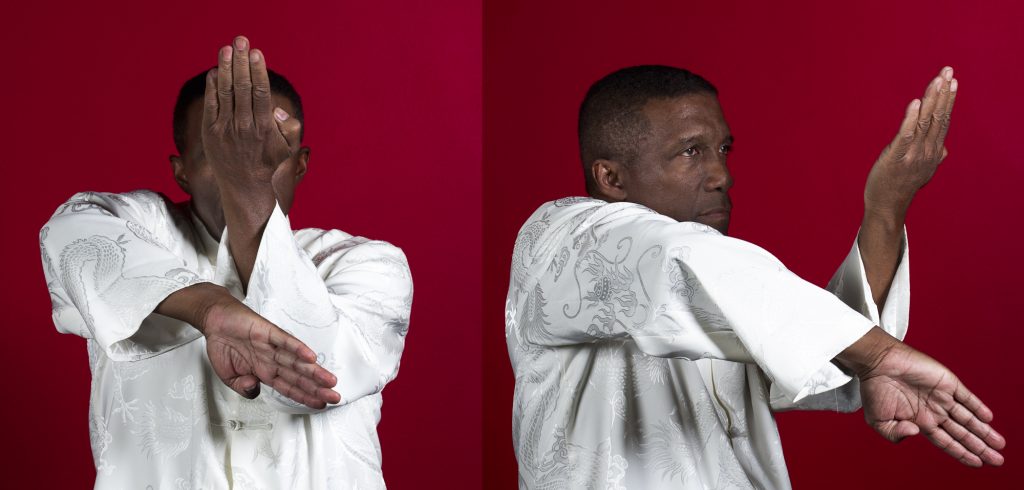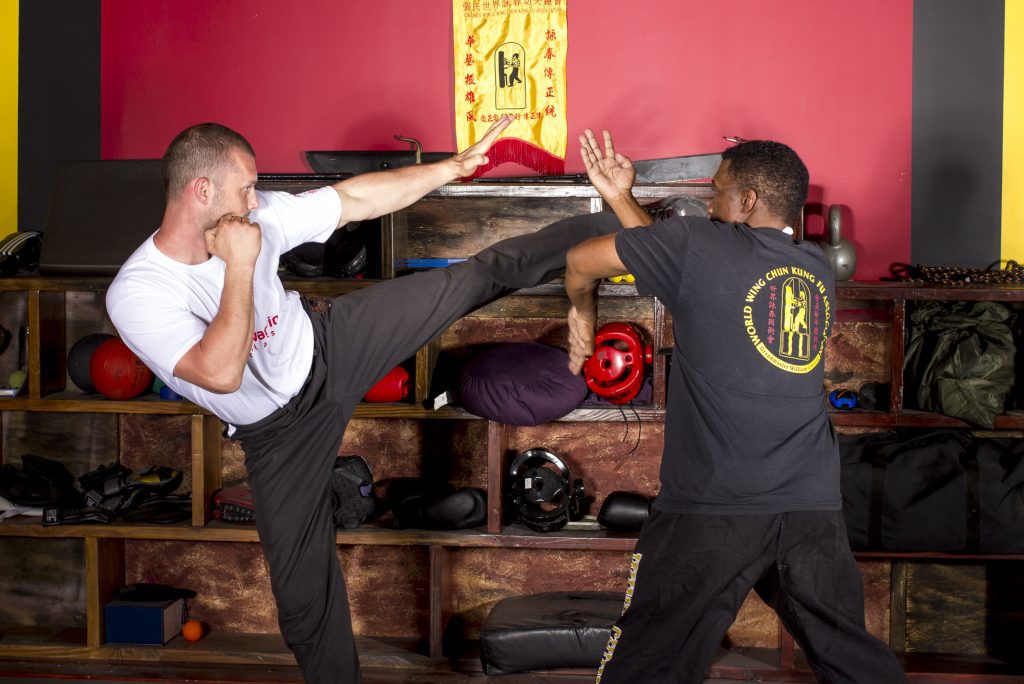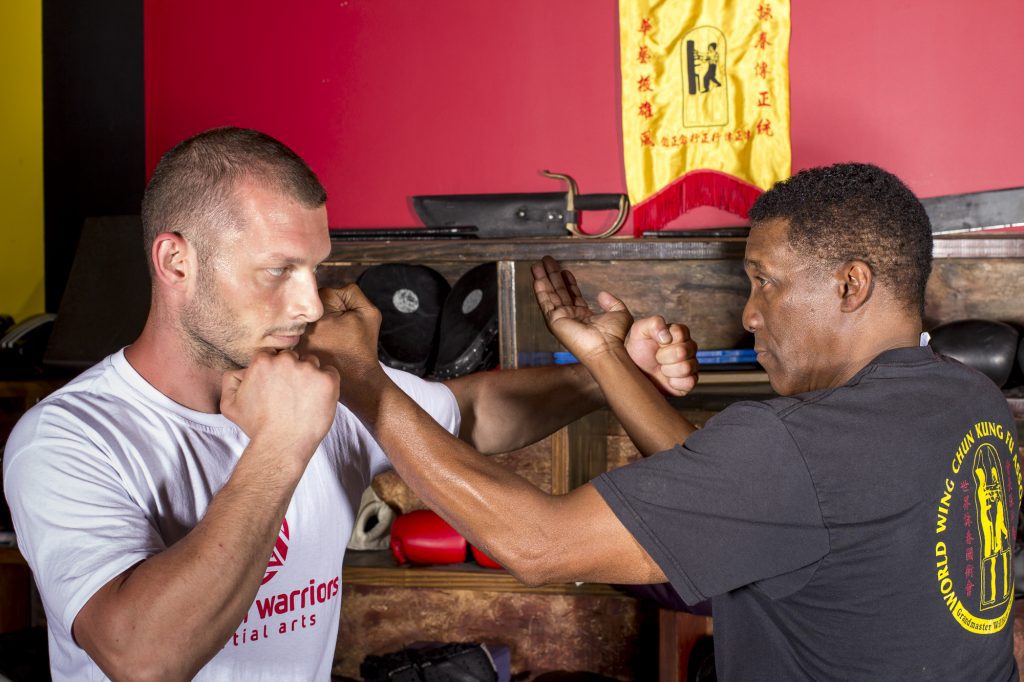I started training in Shorin Ryu 50 years ago under Eizo Shimabukuru when I was a U.S. Marine stationed in Okinawa, after my first tour in Vietnam. When I came back to the States from Vietnam in 1970 I began Kung Fu. I eventually became a Sifu in Wing Chun under Henry Leung before I met GM Cheung. I did the Bai- Si ceremony (closed door student), with GM Cheung in 2007.
Through the years my Wing Chun has changed a lot. I see things differently from when I first started. There is no more mystery to Wing Chun, like I thought there was before. I also don’t believe everything a Sifu says if it doesn’t make sense.
I lived in some very rough neighborhoods in NYC and some people did not believe in the Kung Fu hype of the 70’s. If you said you knew martial arts, it was almost guaranteed that someone would test you. If you look at the photo section on my website you’ll see a group photo of some of the guys I trained with and my Wing Chun brother Johnny Lee who is seated next to me.
When I told Johnny that some guys in the hood did trapping and simultaneous blocking close to what Wing Chun does, he didn’t believe me. A style of fighting called Jail House Rock or 52 Blocks was practiced by prisoners in NYC jails.
Most Kung Fu students won’t come at their Sifu full power. These guys did. They were good at fighting because they had to survive in jail. Mel Gibson learned some JHR for the Lethal Weapon movie. Johnny Lee would come with me to East New York and spar with guys I knew in the neighborhood that fought in jail. He was really good at Wing Chun. His brother is Benson Lee, a well-known Eagle Claw Sifu.
I helped Benson train for his first full contact Fu Jow Pai event in NY Chinatown. Back then in New York, Karate people laughed at Kung Fu. They said we had pretty forms but couldn’t fight. I wasn’t going for that. I was a Marine that recently got out of Vietnam. I fought hand to hand combat with NVA and Vietcong who infiltrated our position. We had to resort to fixed Bayonets because of the close quarters. During the melee my M16 was knocked from my grip. I had to resort to my K-Bar.
That encounter made me take hand to hand combat seriously. I look for what’s practical in a martial art. I don’t care about lineage or style.

How did you meet Grandmaster William Cheung?
I studied with eight different Wing Chun Sifus since 1970. Two of my Sifus were not Yip Man lineage. Four of my Sifus were students of Yip Man. Both Moy Yat and Duncan Leung told me that one of the best fighters under Yip Man was Ah Hing. None of us knew who that was in the 70s.
In 1983 I saw an ad in a martial art magazine about a two week seminar at UCLA with William Cheung (Cheuk Hing) Cheung. I immediately realized who he was. I decided to book a flight from N.Y. to L.A. The seminar fee included a shared dorm room at UCLA and free breakfast and lunch. My first night there I met Sifu Blaine Collins. He was in the U.S. Navy and his ship docked in Australia.
That’s where he met GM Cheung in Melbourne for the first time. Blaine got GM Cheung a position to teach the Sailors and Marines on the ship and eventually got him to come to the States to do seminars.
Blaine knew that I was a Sifu in another lineage and asked me to do my Chum Kiu form. UCLA had some plush carpeting in the dorm lounge. Because of that I was unable to do the left and right shifting in the Chum Kiu form. I even stopped and apologized to Blaine because the carpet didn’t allow me to shift smoothly.
When I was done with the form Blaine explained to me that in the version of Wing Chun he learned from GM Cheung he was taught to pick up your feet and step right and left. That made so much sense to me. You can’t shift on an uneven surface and in my case it was a plush carpet.
You had trained in Wing Chun before you met Grandmaster William Cheung. What persuaded you to stay with Grandmaster Cheung?
During the L.A. seminar, I asked GM Cheung if I could be his student. He said that I was already a Sifu with students and that I didn’t have to forget the Wing Chun I knew but to think more critically about Wing Chun. I was adamant that I wanted to be his student.
When I came back to N.Y. I told my students that I was no longer a Sifu and was closing the school until I learned more from GM Cheung.
I stayed with him because I was kickboxing at the time and what he showed me made sense for full contact fighting. I’m too small to fight a bigger person head on. I liked the concept of fighting on an angle. Some people can fight very well square on. Side body was better for me.
You are experienced in many different styles of Martial Arts including Seven-Star Praying Mantis and Aiki-Jujitsu. What does Wing Chun provide for you personally that other martial arts do not?
My ex-wife did Seven Star and taught me. She studied with Master Chiu Leung in N.Y. Chinatown. I studied Fu Jow Pai under GM Ng Wai Hong in N.Y. Chinatown. I also learned Hung Ga with Sifu Bill Chung when I was in Hung Mun/ Hung Ching (Chinese Freemasons).
There were many Kung Fu styles available N.Y.C.’s Chinatown and I lived in Brooklyn, right across the Manhattan Bridge from a wealth of Kung Fu knowledge.
I even studied Cantonese in college (university), just so that I could grasp concepts from these many Sifus I studied with.
I had my own business back in N.Y. so I was able to take classes with two Sifus in one day. Of course I never mastered these different styles but at least I had a grasp of what their concepts were. I did achieve a Shodan in Aki-Jujitsu though. All martial arts have something to offer. The more martial arts you’re familiar with the better.
There has been a lot of talk lately amongst the community that Wing Chun is becoming too focused on Chi Sao, with many schools doing little else. Do you agree?
That’s a very subjective question. What is too much? I will say that Wing Chun people should concentrate more on light and full contact sparring. We should also train against horizontal punches. Most Wing Chun people only train against the vertical punch. You’re definitely going to experience more horizontal punches in the street.
What constitutes a healthy training regime in Wing Chun?
I’ll be 69 years old in November. Health is definitely important for a martial artist. I’d suggest learning some form of Hei (Qi), Gung. It doesn’t matter the source. Stretching is also important to elongate the ligaments and tendons. In the West a lot older people walk bent over because the ligaments have shortened through the years.

You often emphasise the difference between centre line and central line. Can you explain to us what the difference is?
When you do the lower and upper crossing of the arms in Siu Nim Tau you’re defining the central line parameters. Your fingers are even with each other, which makes it possible to punch at a target without moving your shoulders. If I move my shoulder before I strike it telegraphs my intent and I want to be able to strike without doing so.
The second important part of crossing the arms low then high is that it traces an imaginary border left and right that defines the central lines. When you do so, your fingers must be even to each other. You can test this concept by standing square and placing your two fists out in front of you. From this position you’ll be able to strike a target in front of you without moving your shoulders.

Now without moving your shoulders or waist move both fists slowly either left or right until you reach a point where your fists aren’t even anymore. That is the boundary of your central line. So if you’re in a front stance or a side neutral (Pien San Mah), you should be able to strike a target in front of your without telegraphing with your shoulder.
I teach my students to imagine they are standing in the middle of a square (think of the middle dot of the number 5 on a die). Your centerline is facing to either the left or right upper corner of the square, depending on whether you are in a left or right sided stance. Your opponent is in the center of the square (between the two corners). Your guard is towards the center of the square to cover the opponent.
This creates a 45 degree angle of your body to the center part of the square and the opponent. Hence the term Side Body
What are the advantages of fighting with a side-body stance?
Most Wing Chun is Jung San (center line). Leung Jan taught Pien San (side body) Wing Chun when he moved back to his native village of Gu Lo. Most Wing Chun is Jung San (center line). Our Wing Chun is like the Wing Chun that Leung Jan taught when he moved back to his native village of Gu Lo. It is Pien (Side Body).
The difference is that we don’t face an opponent square on. We “blade” on an angle like boxers do. Blading minimizes your target area. This is really important if you’re a smaller person. But if you’re larger and stronger than your opponent then fighting down the middle is a lot easier. I think knowing both methods gives one an advantage.
The bottom line is that you’re a smaller target with Pien San.
Your Tan Sau extends a little higher than usual. Can you explain to us why it is performed this way in your lineage?
I used to wonder why other people’s Tan Sao/u are so low and not covering the upper gate. I understand the purpose of a mid-level Tan, but most fighters are head-hunters.
I believe in training for what you’ll encounter in the street. It’s just common sense to train for the inevitable. I’ve heard through the years that since Chan Wah Shun was taller than most Southern Chinese he had to use a lower Tan when training with shorter people.
Of course, I can’t say for sure if that’s true. When people say our Tan is too high I wonder if they understand the concept of upper, middle, and lower gate. Our Tan is not “too high”. It just simply covers middle to upper gate.
Why does Wing Chun chamber so high up, near the floating ribs. What benefits does this provide?
Having studied other Southern Chinese martial arts I asked that question when I first started learning Wing Chun. Different Sifu have taught me the same thing but in different words. To summarize, what I learned through the years is that using a high chamber restricts thoracic, shallow breathing. With a high chamber you have to breathe using your diaphragm which promotes deep abdominal breathing which is the correct way to breathe. If you use a low chamber, you can expand your chest when you inhale. That is called Thoracic Breathing and is incorrect. Babies breathe correctly. We lose that as we get older.
What advice would you give to young practitioners who are just starting out in Wing Chun?
Don’t get involved with lineage superiority and the “Sifu Sez” syndrome. No Wing Chun lineage has all the answers. There is no best Wing Chun. It’s an individual journey — take what works against a resisting opponent who is trying to hurt you and use it. Ω



7 Comments
Whoa, great to read about u, my brother Benson whom u are close to now ,fwd this to me. I had a feeling u knew more than u let on to be. The USMC background was a clue
Wing Chun is not just a combat sport but a way of life. It in composites mind, body, and lifestyle. Language is one form of mind over communication. And, Sifu Redmond was Bruce Lee level in speech. Well done Sifu.
Thank you for sharing your knowledge.
Wing Chun is a tool for protecting yourself and your loved ones.
But it needs honesty to yourself to see what is working and what is not.
I learned from my sifu who originated in indonesia.
It helped me to stay flexible, strong and fit to help my dear wife when she was terminally sick.
I had my biggest fight ever in life to survive.
The true purpose of self cultivation is just that, for helping each other, not destroying.
But too understand that in heart and soul took many years.
The debate which wing chun is more effective is useless.
The debate should always be :
How can I improve what I am doing ?
Dont make your wing chun a ” dead” wing chun.
The lineage is not important, sometimes the lineage story is made more appealing for the public just for commercial goals.
And thats ok , these guys have to earn a living too.
As long as they know what they are doing and are honest in their teaching, its all fine.
Just a practitioner with a clear goal in life and death.
Sinjo Tjil
While I understand the appeasing sentiment behind the statement, “There is no best Wing Chun,” it is a false statement, and obviously so. The proof of that it is false is that there is a lot of inferior Wing Chun being practiced “out there.” Can you disagree? For the statement, “There is no best Wing Chun” to be true, all Wing Chun would have to be the same–and that certainly isn’t true.
Die Behauptung, dass alle Wing Chun gleich sein müssten, damit es kein bestes gibt ist eindeutig falsch. Das es minderwertiges Wing Chun gibt, ist deine Wertung und deine Erfahrung, die nicht auf andere übertragen werden kann. Seine Aussage ist: “Kein Wing Chun hat alle Antworten.” Man sollte das nehmen, was wirkt, so sein Rat. Wing Chun als individuelle Reise und wenn es “minderwertig” anfängt und sich weiterentwickelt ist man schon auf dem richtigen Weg. Also sei offen für andere Stile und lerne von ihnen!
[…] To be taught extra about Sifu Phillip Redmond you may examine the interview on Wing Chun Origins Journal right here. […]
[…] To study extra about Sifu Phillip Redmond you’ll be able to examine the interview on Wing Chun Origins Journal right here. […]